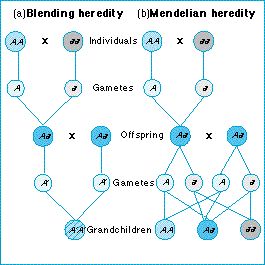Molecular and Mendelian Genetics - What are the laws of heredity?

The Modern Synthesis
Mendel's theory of heredity plugged a dangerous leak in Darwin's original theory, and the two theories together eventually came to form the synthetic theory of evolution, or neo-Darwinism. The problem had been Darwin's lack of a sound theory of heredity.
Before Mendel, most theories of heredity were blending theories. Suppose there is a geneA that causes its bearers to grow up dark blue in color, and another genea that causes its bearers to grow up white. In our imaginary world of blending heredity, individuals are diploid and have two copies of each “gene”. An individual could then either inherit an AA genotype from its parents and have a dark blue phenotype, or inherit an aa genotype and have a white phenotype, or an Aa genotype and have a light blue phenotype. (We should say there is no dominance between theA and a genes.)
The interesting individuals for this argument are the ones that have inherited an Aa genotype and have grown up to be light blue. They could have been produced in a cross of a dark blue and a white parent: then the offspring will be light blue whether inheritance is Mendelian (with no dominance) or blending. But now consider the next generation.
• Under Mendelian heredity, the light blue Aa heterozygote passes on intact to its offspring the A and a genes it had inherited from its father and mother.
• Under blending heredity, if an individual inherited an A and an a gene, the two would physically blend in some way to form a new sort of gene (let us call itA' )that causes light blue coloration. And instead of producing 1/2 A gametes and 1/2 a, it would then produce all A' gametes. This makes a difference in the second generation.
Whereas in Mendelian heredity, the dark blue and white colors segregate out again in a cross between two heterozygotes, in the analogous cross with blending heredity they do not - all the grandchildren are light blue.
In a blending mechanism, the “genes” are not preserved. The genes that an individual inherits from its parents are physically lost, as the two parental sets are blended together. In Mendelism, it is perfectly possible for the phenotypes of the parents to be blended in the offspring, but the genes do not blend.
Why does this preservation of genes matter for Darwinism?
Natural selection is a more powerful process with Mendelian heredity, because Mendelian genes are preserved over time; whereas it is at best a weak process with blending inheritance, because potentially favorable genes are diluted before they can be established.
Figure: (a) blending heredity. The parental genes for blue (A ) and red (a ) color blend in their offspring. (b) Mendelian heredity. The genes are passed on unaltered by the offspring.
| Next |



